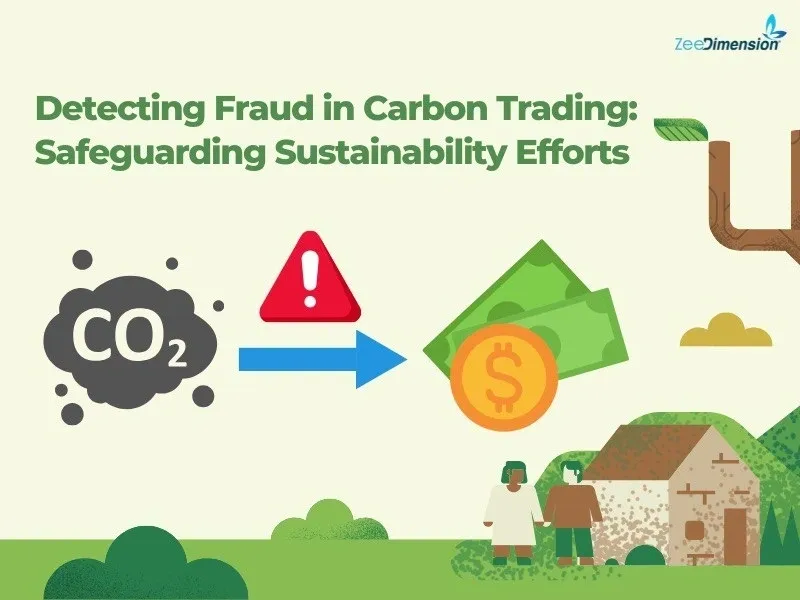
What is Carbon Trading?
As the globe grapples with the mounting effects of climate change, carbon trading has emerged as an important approach to reducing greenhouse gas emissions. This concept is based on the cap-and-trade system, which limits emissions and allows businesses to buy and sell carbon credits. These credits allow a certain level of carbon dioxide emissions, allowing enterprises that reduce their emissions to sell extra credits to those who exceed their limitations.
Carbon trading is more than just an economic instrument; it is critical to global climate action. Giving carbon emissions a financial value pushes businesses to innovate and adopt cleaner technology, thus facilitating the transition to a low-carbon economy. As countries attempt to meet climate objectives, understanding carbon trading is vital for supporting sustainable practices.
Why Fraud is a Threat to Sustainability
Fraud is a huge threat to sustainability, especially through techniques such as greenwashing, in which firms falsely claim environmental benefits to appear more eco-friendly than they are. Such false practices erode the credibility of genuine sustainability efforts and skew market signals, making it more difficult to accomplish meaningful environmental progress. Transparency is critical for ensuring the integrity and effectiveness of carbon markets. Clear reporting, third-party verification, and strict control are required to maintain trust and ensure that carbon trading contributes to global climate goals.
Types of Fraudulent Activities
📷
1- Greenwashing: False claims of environmental responsibility.
2- Falsifying Emissions Data: Misreporting or underreporting actual emissions.
3- Counterfeit Carbon Credits: Selling used or nonexistent credits
Case Studies of Carbon Trading Fraud
CASE 1: Volkswagen Emissions Scandal
Details: Manipulated emissions tests to underreport pollution by 40%.
Numeric Impact:
11 million vehicles are involved globally.
1 billion tons of excess CO2 emissions unaccounted for.
Financial impact: fines. $33 billion in
CASE 2: Counterfeit Carbon Credits in Developing Markets
Fraudulent sale of 10,000 carbon credits (10% of a 100,000-credit market).
Market Loss: $200,000 in fraudulent transactions.
Environmental Cost: 10,000 metric tons of unverified emissions.
Case 3: Brazil’s Deforestation Carbon Offset Fraud
Credits were issued for stopping deforestation, but deforestation continued.
An estimated 50,000 credits were issued fraudulently, resulting in $1 million in unearned profit.
Environmental Impact: Ongoing deforestation undermined carbon sequestration efforts.
Tools and Techniques for Detecting Fraud
AI in Fraud Detection
-
AI can analyze vast datasets and identify anomalies.
-
Numeric Scenario:
AI detection efficiency can reach 95%, compared to manual audits detecting 60%.
Potential savings: $10 million annually in fraud prevention.
Blockchain for Carbon Credit Transparency
-
Blockchain ensures the traceability of every carbon credit transaction.
-
Impact: Reduces fraud by 80%.
-
If a market handles 500,000 credits, blockchain prevents fraud for 400,000 credits, securing $8 million in market value.
Third-Party Verification
-
Requires independent audits of carbon credit projects.
-
Impact: Reduces the risk of greenwashing by 70%.
-
Cost Efficiency: For every $100,000 spent on third-party audits, it could prevent $500,000 in fraudulent credits.
Data Integration and Reporting Standards
-
Using advanced reporting tools and integrating real-time data from environmental monitoring sensors.
-
Impact: Improves accuracy of emissions reporting, reducing data falsification by 50%.
-
For a project issuing 100,000 credits, this could prevent 50,000 tons of unaccounted emissions.
Strengthening Regulatory Frameworks
Global rules and standards, such as ISO 14064 and the GHG Protocol, are critical to guarantee the accuracy and reliability of greenhouse gas emission reporting. These international standards offer organizations a framework for properly measuring and managing their emissions. Noncompliance, on the other hand, can have serious consequences, as illustrated in 2022 when over 2 million counterfeit carbon credits were discovered, resulting in a $40 million loss. This case emphasizes the need to adhere to these criteria to prevent fraud and ensure the integrity of carbon markets.
Challenges in enforcing carbon trading regulations are significant, primarily due to fragmented regulatory frameworks across different countries. In 2023, these regulatory gaps led to 10% of carbon credit fraud cases going unaddressed, affecting approximately 500,000 credits globally. This highlights the urgent need for a more cohesive and standardized approach to regulation to ensure the integrity and effectiveness of carbon markets.
Safeguarding the Future of Carbon Trading
1- Ethical market development requires robust collaboration between governments, NGOs, and corporations to ensure the integrity and effectiveness of carbon markets. By working together, these entities can create a well-regulated market that significantly reduces fraud. For instance, reducing fraud by just 10% in such a market could lead to a reduction of 1 billion tons of CO2 globally by 2030, highlighting the immense potential of ethical practices in achieving substantial environmental benefits.
2- Technological advancements, particularly blockchain and AI, are poised to revolutionize carbon trading by enhancing security and transparency. These technologies are expected to reduce carbon trading fraud by 70% over the next decade, potentially preventing over $2 billion in fraudulent transactions. By ensuring more secure and transparent transactions, blockchain and AI can significantly bolster the integrity of carbon markets and support global sustainability efforts.
In Conclusion :
Fraud in carbon trading poses significant risks to both financial and environmental objectives. However, advanced technologies like AI and blockchain can play a crucial role in mitigating these risks. To ensure the success of carbon markets, it is essential to implement strong regulatory frameworks and third-party verification. As we race toward sustainability, protecting the integrity of carbon trading is paramount. Transparency and accountability will ensure that these systems truly benefit the planet.







